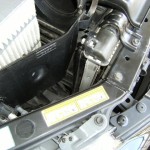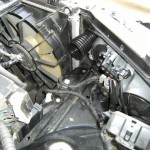 Last time I showed you how I measured the intake restriction on project Lexus. Hopefully seeing how easy it is done has now inspired you to go out and take some measurements of your own.
Last time I showed you how I measured the intake restriction on project Lexus. Hopefully seeing how easy it is done has now inspired you to go out and take some measurements of your own.
Let's Review
So before we get started, let me quickly review some of what we learned in the past two articles. First of all, we discussed how you can use a vacuum gauge or differential pressure meter to measure intake restriction.
I then showed you on the IS300 exactly how I tapped the intake system in various places to determine where the intake restriction was. Anywhere I tapped the intake system I knew that the restriction from that point FORWARD (towards the front of the intake system - ie the snorkel and in fact, the open atmosphere).
I also told you that, surprisingly, the IS300s intake system is actually quite good even in completely stock form. The total pressure drop on this car, with a bone stock intake system was only -9.1 inches of water (among one of the better stock systems I've measured). This pressure drop was measured on a previously modified engine as well. This means that if anything, the pressure drop on our car would be higher than or equal to the stock car. I suspect it would be the same.
Putting the Restriction into Perspective
-9.1 inches of water is -0.0327 psi of restriction. That's at peak power with the throttle wide open in the worst case scenario. It turns out that because of the way the intake snorkel is forward facing, it actually takes advantage of the air pressure building up on the car as it moves forward. Therefore, as the car goes faster, that restriction is actually alleviated, creating a bit of a "ram air" effect. Something completely lost by most 'short ram' intake systems. At around the fastest this author is willing to go on a public road, 85-90 mph there is practically no restriction at all in stock form, a mere -3.5 inches of water.
To give you a bit of perspective. I have seen cars with restrictions as high as -30 inches of water. As you might imagine, the higher the number, usually the easier it is to get it lower, and, the bigger and more impressive horsepower gain you get when you reduce it. -30 inches of water, by the way is like running a full negative psi of boost - that's -1.08psi of restriction. Not good.
So, all of this to say, the IS300 is not going to gain huge horsepower numbers from replacing the intake system regardless of what the intake makers claim. So is it really worth spending several hundred dollars to improve this cars intake ? Perhaps more on that in a later article, but for now, suffice to say - that's the kind of feedback that this sort of testing gives you. You can honestly assess whether or not something NEEDS to be modified before forking out hundreds of dollars because some 14 year old in Omaha said it made their car faster.
Addressing the Restriction
Looking at the restriction numbers I took, we find that the largest amount of restriction seems to be after the filter up to the throttle body. This means that it's being caused by the intake arm or the MAF sensor, or perhaps the very rear of the intake box which is admittedly a bit of a mess.
Unfortunately, we did not take a measurement before and after the MAF yet so we do not know for certain that it is the MAF sensor that is causing our restriction. I do know from some testing we did later on with an aftermarket solution that the intake arm is the source of only a VERY small amount of the total restriction.
 I am quite confident that the rear of the air box and the MAF itself are the source of the majority of that -9.1 in H2O total restriction. The MAF is a device that measures air flow, air temperature, and velocity on the IS300. It's very common on many vehicles though some use a MAP sensor (which measures manifold absolute pressure instead). MAP sensors are commonly used on Hondas. The MAF on the IS300 also happens to be the smallest part of the intake system and has a fairly abrupt opening into the main airbox.
I am quite confident that the rear of the air box and the MAF itself are the source of the majority of that -9.1 in H2O total restriction. The MAF is a device that measures air flow, air temperature, and velocity on the IS300. It's very common on many vehicles though some use a MAP sensor (which measures manifold absolute pressure instead). MAP sensors are commonly used on Hondas. The MAF on the IS300 also happens to be the smallest part of the intake system and has a fairly abrupt opening into the main airbox.
The issue with MAFs is that they are calibrated for a certain size pipe. So changing pipe sizes on MAF cars is more difficult. On a MAP car, you can pretty much do whatever you like with the pipe size as it will not effect the MAP sensor.
Looking down the list we made last time, we see that the air filter is imposing basically 0 restriction at a rather small -0.8 inches of water PEAK. I've tested other filters on this car and they were either the same or worse. That includes HKS, AFE, and K&N. This measurement was also taken on a slightly dirty OEM filter, which, by the way, unless extremely filthy (like, caked in dirt), they do not flow poorly at all.
Finally, we see a -2.3 inches of water restriction lurking about in the snorkel. This means that the factory pick-up point for the intake is slightly undersized.
Approaches
Note: I should note that some of the numbers may not seem to add up in this section, and that's primarily because I tested a number of different variations on the intake. Unfortunately, I cannot talk about all of them here and some of them I'll be talking about next time. I will however tell you the relevant comparison numbers wherever possible, just don't expect all the math to add up - in this part anyway.
Interestingly, on Project Lexus, while looking for ways to improve the factory air box, I noticed that the hood seal on the car was actually slightly hanging in front of the factory snorkel. From the impression in the rubber, I could tell that it had actually been this way for some time. After taping the rubber seal back so the hood wood seal to the snorkel correctly, I took the car back out for a drive and saw nearly a full inch of water restriction, disappear. Literally, the entire life of this car, it's been running down on power thanks to that misaligned hood seal. I never noticed it before as I naturally never really checked to see how the hood seal was landing against the snorkel until this project.
So looking to actual modifications, we could replace the MAF sensor with something larger, but we'd have to go through the complicated process of recalibrating it. Which, it turns out is not terribly cheap.
So while that's the main cause of restriction, we may just have to live with it. Considering it's a mere -5.2 inches of water, we are probably okay with that.
Getting rid of the restriction in the snorkel area seems to be the most likely to succeed. However, how?
 During my testing, I did notice that if I removed the lid to the airbox, I got a peak figure of just over -6 inches of water. If I could recreate that same restriction amount, but suck air from outside the engine bay - I'd be happy.
During my testing, I did notice that if I removed the lid to the airbox, I got a peak figure of just over -6 inches of water. If I could recreate that same restriction amount, but suck air from outside the engine bay - I'd be happy.
To get more air into the intake box, typically, I'd just hog out the factory snorkel and fit a big ole pipe in its place. However, due to the cramped engine bay, and the fact that the factory snorkel is up over the radiator, this had to be ruled out early on.
However, a second or even third intake snorkel could be fitted.
When you look at the IS300's air box, you'll find that unfortunately, due to the way it's constructed, there's really no place to run a secondary intake snorkel, and it's also very difficult to enlarge the primary intake snorkel. Like most cars, the intake box is fairly umm.. boxed in by other items in the car. It's also not possible to bore a hole under the box and run a pipe down into the fender liner, as the frame rail is directly below the airbox and then there's the way the filter sits in the airbox getting in the way.
After close examination, there seemed to be only one place to run a secondary intake snorkel - the front of the box behind the headlight. It gave an entry that was in front of the filter and could accommodate a decent size secondary snorkel.
I took some pressure measurements on the front of the air box (taped the hose flat to the airbox) to see if there was positive aerodynamic pressure building up there. It did turn out to have slightly positive pressure building against it. Good news. However, if I just drilled a hole it would likely also suck up hot engine bay air and this wasn't necessarily fully desirable.
I could have simply cut a 3" hole and attached a flared bell mouth as I had intended. Frankly, at cruise speeds it's isolated enough and in an area of fresh air intake that it'd have acceptable intake air temps.
 However, I noticed there's a small gap between the radiator and the headlight that I could run a hose through. I found that a 2.5" OD hose from a shop vac was just small enough to fit in the hole, however, it would be squished a bit on the sides. However, due to the pipe being flexible, it'd fit fine, have the same cross sectional area even where it was squished and allow me to isolate the new intake from the engine bay heat.
However, I noticed there's a small gap between the radiator and the headlight that I could run a hose through. I found that a 2.5" OD hose from a shop vac was just small enough to fit in the hole, however, it would be squished a bit on the sides. However, due to the pipe being flexible, it'd fit fine, have the same cross sectional area even where it was squished and allow me to isolate the new intake from the engine bay heat.
It will not flow as well as if it did not have that kink, but the idea here is simply to give the engine a little more air at WOT than it currently gets from the stock intake snorkel.
 I originally ran the shop vac hose down to the lower grill. This was probably less than optimal as it forced there to be 2 additional tight bends in the hose. However, on the road, a 1.2 inch of water improvement was measured consistently. Nearly half of the original restriction posed by the factory snorkel.
I originally ran the shop vac hose down to the lower grill. This was probably less than optimal as it forced there to be 2 additional tight bends in the hose. However, on the road, a 1.2 inch of water improvement was measured consistently. Nearly half of the original restriction posed by the factory snorkel.
That does not tell the whole story however. At a 65mph cruise, the positive pressure in the air box went from 1.5-1.8 inches of water to a very respectable 2.0-2.3 inches of water. Without getting too into it in this discussion, a positive pressure on the throttle plate during cruise gives better fuel economy by reducing pumping losses (losses due to the engine having to work to get air into it), and, it also provides better throttle response. A very good result indeed!
On the road, this setup yielded an obvious pick up in power and as an added bonus, added no additional noise. If anything, there is a slightly deeper sound to the intake system, but my decibel meter did not register any increase in actual noise.
By removing the hood seal restriction and fitting the first trial secondary snorkel, I was able to reduce total intake restriction to just -6.5 inches of water. That -6.5 inches of water against measured as the peak restriction under worse case scenarios (ie, first gear). I should not here that an aftermarket intake arm was also fitted to achieve that value. However, as you'll find out next time, the aftermarket intake arm contributed quite little to achieving the -6.5 inches of water result - in fact, the few dollars of hose made a bigger difference. I will break down the exact 'gains' and what caused them in the next article.
For a few dollars and a bit of time/creativity - you can do this stuff too and using your vacuum gauge, you'll know FOR SURE that you actually made things better!
Next time, we'll refine the new modified intake system and talk a little more about how we evaluated the changes.
Extremely Limited Time Offer - 3 Days Only
Get a MASTERS DEGREE in Performance Tuning from the BEST in the Field for ONE low package price
For 3 days only, get ALL of our PREMIUM (not available anywhere else) Tuner University Courses featuring some of the greatest minds in motorsports:
- Top 10 Performance Myths Class (MP3 and Edited Transcript) - $29.95 value
- Performance on a Sip of Fuel Class (MP3 and class manual) - $69.95 value
- Header Design Secrets with John Grudynski (MP3 and transcript) - $69.95 value
- Dirty Secrets of Oil with Ryan Stark (MP3 and transcript) - $69.95 value
- Engine Tuning Secrets with Ben Strader of EFI University (MP3 and Transcript) - $69.95 value
Get all of the above courses (many of which not currently available anywhere else) for one single price of just $309.75 $69.95. A HUGE package savings.
You can also buy any of these individually through our resource center, but I don't know why you would as this is basically the whole store for the price of just 1 course. You'll get the MP3 recordings of each class as well as a transcript or companion manual with each course and you'll be able to download them all INSTANTLY.





